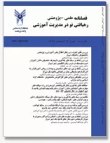Development of students 'satisfaction model from the virtual studio of architectural design and implications for educational administrators (Case study: Marvdasht boys' , Bahonar Shiraz and Alzahra Shiraz vocational technical colleges)
Due to the spread of the coronavirus in the world, education was shifted to a virtual environment, and the continuation of the architectural education process, as well as training courses, due to the closure of universities, became possible only in the virtual context. This causes problems in the way of teaching and the result is a decrease in learning efficiency. For this purpose, in order to understand the current situation and improve the process of teaching architectural design in the corona pandemic, in the present study, the factors affecting students' satisfaction with the virtual architectural design studio have been developed and evaluated. The present research is mixed Method Approach using the research and has been done in 3 stages. First, the 7-step meta-synthesis method of Barrow Su and Sandlowski has been used and the initial conceptual model of the research has been formed. Kappa-Cohen coefficient was used to evaluate the reliability of qualitative meta-combination research. Then, in the second stage, by distributing a questionnaire among the instructors of the studio, a supplementary model of the research was obtained, and in the third stage, in order to quantitatively validate the proposed model, various tests and confirmatory factor analysis were used. Also, to check the accuracy of the hypotheses and test the proposed model, we have used structural equation modeling and path analysis method by Smartpls3 software. After confirming the favorableness of the path coefficients and the significance of the coefficients (t-value), we have studied the research model based on various indicators, the results of which showed the suitability of the proposed model. After performing the above steps, the scientific adequacy of the research model was confirmed. Thus, the research model with 4 dimensions: technical facilities and equipment, teaching quality, learning quality and educational content quality with 12 components and 31 indicators was finally approved.
- حق عضویت دریافتی صرف حمایت از نشریات عضو و نگهداری، تکمیل و توسعه مگیران میشود.
- پرداخت حق اشتراک و دانلود مقالات اجازه بازنشر آن در سایر رسانههای چاپی و دیجیتال را به کاربر نمیدهد.



